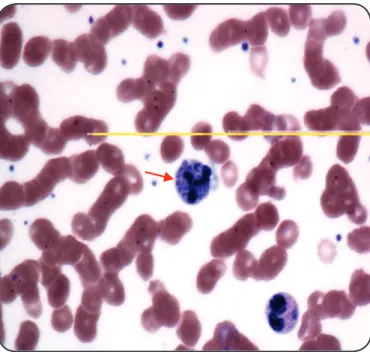148
Rev Soc Bras Med Trop 50(1):148, January-February, 2017 doi: 10.1590/0037-8682-0189-2016
Images in Infectious Diseases
Corresponding author: Dr. André Luiz Maltos.
e-mail: andremaltos@yahoo.com.br
Received 2 June 2016
Accepted 8 July 2016
Disseminated histoplasmosis diagnosed
in a peripheral blood smear
André Luiz Maltos
[1], Evaldo Maia
[1]and Cristina da Cunha Hueb Barata de Oliveira
[2][1]. Serviço de Patologia Clínica, Hospital de Clínicas, Universidade Federal do Triângulo Mineiro, Uberaba, MG, Brasil.
[2]. Disciplina de Doenças Infecciosas e Parasitárias, Faculdade de Medicina, Universidade Federal do Triângulo Mineiro, Uberaba, MG, Brasil.
FIGURE 1 - Peripheral blood smear - multiple yeasts in neutrophil (arrow).
1,000x magniication – Giemsa staining).
A 40-year-old man with human immunodeiciency virus (HIV) infection, diagnosed in 2008, and irregular use of antiretroviral therapy, was admitted to the emergency room with diarrhea, asthenia, fever, and weight loss of 4kg in the previous 10 days. His evacuations were watery, with no mucus or blood. He was emaciated, with an axillary temperature of 38.3°C. Cardiopulmonary auscultation indings were normal, and the abdomen was not tender, without visceromegaly. The skin showed generalized hypo- and hyperchromic spots. The patient was hospitalized, and laboratory tests were performed. The complete blood count showed anemia, leucopenia, and a normal platelet count; the serum level of C-reactive protein was 43mg/dL (reference: ≤0.5mg/dL). The cluster of differentiation 4+ (CD4+) cell count was 6.0/mm3, and the viral load was
undetectable. In the peripheral blood smear, neutrophils with multiple yeasts were observed, suggestive of Histoplasma capsulatum (Figure 1). He was treated with amphotericin B, which reached a cumulative dose of 840mg (in 40 days). He was discharged and prescribed itraconazole. After 3 months, he developed a disseminated cryptococcosis (treated with amphotericin B and luconazole), and died 1 month later, following bacterial pneumonia with septic shock.
Yeasts can grow in the blood of patients with disseminated histoplasmosis, and in severe acute cases, yeasts can be detected inside white blood cells on a peripheral blood smear or buffy coat preparation1,2. Detection of circulating Histoplasma capsulatum
polysaccharide antigen in urine and serum is used for rapid diagnosis. The sensitivity of the urine assay is approximately 90% among patients who have acquiredimmunodeiciency syndrome (AIDS)1,3.
Acknowledgments
We offer thanks to the Federal University of Triângulo Mineiro, who provided technical support for the development of this study.
REFERENCES
1. Kauffman CA. Histoplasmosis. Clin Chest Med. 2009;30(2):217-25. 2. Kurtin PJ, McKinsey DS, Gupta MR, Driks M. Histoplasmosis in
patients with acquired immunodeiciency syndrome. Hematologic
and bone marrow manifestations. Am J Clin Pathol. 1990;93(3): 367-72.
3. Connolly PA, Durkin MM, LeMonte AM, Hackett EJ, Wheat LJ. Detection of histoplasma antigen by a quantitative enzyme
